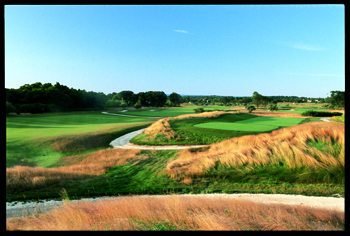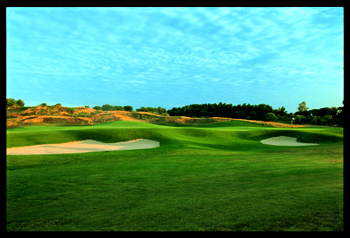Featured Golf News
Newport National - Newer Course amid Historic Americana
Who knew there were so many ways to spend a weekend in Newport that didn't involve traipsing through one "Gilded Age" mansion after another?

The First of Consecutive Par-3s
Begins at the 3rd Hole
Granted, a tour of The Breakers, the 70-room, 138,000-square-foot ocean-side summer "cottage" built by the Vanderbilts at the turn of the 19th century, will take your breath away. When you consider the 15 bedrooms (and 33 more for servants), 300 windows and 750 doorknobs, the most remarkable statistic might be that only two years were required to construct the colossal property.
But that's not the only way to experience a city that blends Old World sophistication with a modern sensibility. Newport attracts the celebrated and prosperous alongside the young and ambitious. Venture to Bowen's and Bannister's Wharf and you'll encounter an eclectic collection of lifestyles, with visitors in T-shirts and cargo shorts walking alongside those in polo shirts and Nantucket red slacks.
Of course, golf was a major part of the weekend, and that came with a visit to Newport National Golf Course in nearby Middletown. Originally a 200-acre nursery, this Arthur Hills-designed layout opened in 2002 and is considered one of New England's finest public courses. With a dramatic setting near the Sakonnet River coastline, the Orchard Course resembles a Scottish links layout, with a succession of deep and penal bunkers; wide, sloping fairways; elevated, mounded greens; and subtle undulations on the putting surfaces.

Bunkers are Prevalent at Newport National;
Here Are a Few at the 14th
The par-72, 7,244-yard layout plays to a 74.4 rating and 138 Slope. The gold tees (6,553 yards, 71.9, 130) provide ample challenge. Newport National has been honored by Golf Digest and Golfweek as one of Rhode Island's top public courses, and it was easy to see why after playing only a few holes. Each hole is unique, with doglegs in both directions, postage-stamp greens, strategically placed bunkers and forced carries over hazards that demand proper club selection.
The course opens with a challenging par-5 that demands a drive over a hazard, followed by a second shot that must be landed short of a deep fairway bunker. In keeping with the links-style design, more pot bunkers lie in wait on both sides of the fairway, and the long approach on the 440-yard par-4 must avoid additional bunkers.
One of the intriguing aspects of the course is the back-to-back par-3s at Nos. 3 and 4 that play in opposite directions and check in at 198 and 170 yards, respectively. The third hole features an elevated, mounded green and is set against a massive grouping of old Japanese pieris - an ornamental shrub that when flowering in the spring takes on the look of blooming gorse from the British Isles. A word to the wise: keep your tee shot to the right on the fourth hole.

Don't Go Left on the Par-3 4th
While the 483-yard par-4 sixth (rated the No. 1 handicap hole) is a bear, the most interesting hole is the 567-yard par-5 eighth. The blind tee shot on this 90-degree dogleg-right should be hit over a bank of trees, reminding one of the tee shot over the Old Course Hotel on the famous Road Hole at St. Andrews. Three bunkers guard the right side of the green, with a pot bunker left. The hole ends at a green shaped as a perfect rectangle.
Members have been known to complain about the 10th, which some view as unfair. At 408 yards, it's certainly a challenge, especially when you must be careful not to hit your tee shot too far lest you find a cross-hazard. The approach then demands a full carry over that area, although there is bailout space to the left.
Tnhe meat of the course is its final four holes. If you play from the tips, you'll face three par-4s measuring 432, 489 and 415, and a 253-yard par-3. Even moving up to the next set of tees isn't a bargain, with the shortest par-4 still 381 and the par-3 a healthy 212.
The 432-yard 15th usually plays into a crosswind, while a fairway bunker runs down the entire left side on the mammoth 17th. The finishing hole? Uphill and into the wind.
Clearly, Newport National will test your game all the way to the final shot. For more information, visit www.newportnational.com.
Wonderful After-Golf Options
My lodging for the weekend was the stylish Forty 1° North hotel, which is centrally located on Thames Street and features sweeping views of Newport Harbor. Upon check-in, which did not involve a registration desk but a receptionist with a laptop computer, we were escorted to what was literally the "room with a view." With an oversized balcony overlooking the harbor, it provided the idyllic spot to sip coffee in the morning or champagne in the evening while watching the sailboats and magnificent sunsets.
The nearby Red Parrot is one of the city's hottest destinations. The building has stood since 1898 and is listed on the National Register of Historical Places. Originally a meatpacking house, it employed hundreds of people during the "Gilded Age" and has been home to a wide range of restaurants that have hosted heads of state, diplomats, royalty and movie stars. The wrap-around bar and hardwood floors bring to mind the atmosphere of an English pub, and we had no problem lingering over a glass of wine or two as the late afternoon shifted into evening.
Newport's downtown offers a plethora of options for shopping, dining or enjoying a beverage, with many of them located at the lively Bowen's Wharf and Bannister's Wharf. The Clarke Cooke House at the center of Bannister's Wharf provides the quintessential Newport experience. There are four levels of dining in the 18th-century building (each with separate menus and pricing), all open to the sights and sounds of the wharf. Not far away is 22 Bowen's, favored by diners seeking a classic steakhouse.
The Vanderbilt Grace is another legendary location. Built by Alfred Gwynne Vanderbilt in 1909, the mansion today is a hotel with 33 rooms and suites, a spa, outdoor pools, two restaurants and a fabulous rooftop bar with dazzling city and harbor views. Not far away are the pristine grass courts of the International Tennis Hall of Fame, where a museum honors the legends of the game, from Bill Tilden to Bjorn Borg to Pete Sampras.
For more information about the sites of Newport, visit www.gonewport.com.
Rob Duca is an award-winning sports columnist who wrote for the Cape Cod Times for 25 years, covering golf, the Boston Red Sox, the Boston Celtics and the Boston Bruins. He is now managing editor of Golf & Leisure Cape Cod magazine and has written for a variety of other publications, including Sports Illustrated, the Boston Globe, Yankee magazine and Cape Cod Life.
Story Options
 |
Print this Story |
